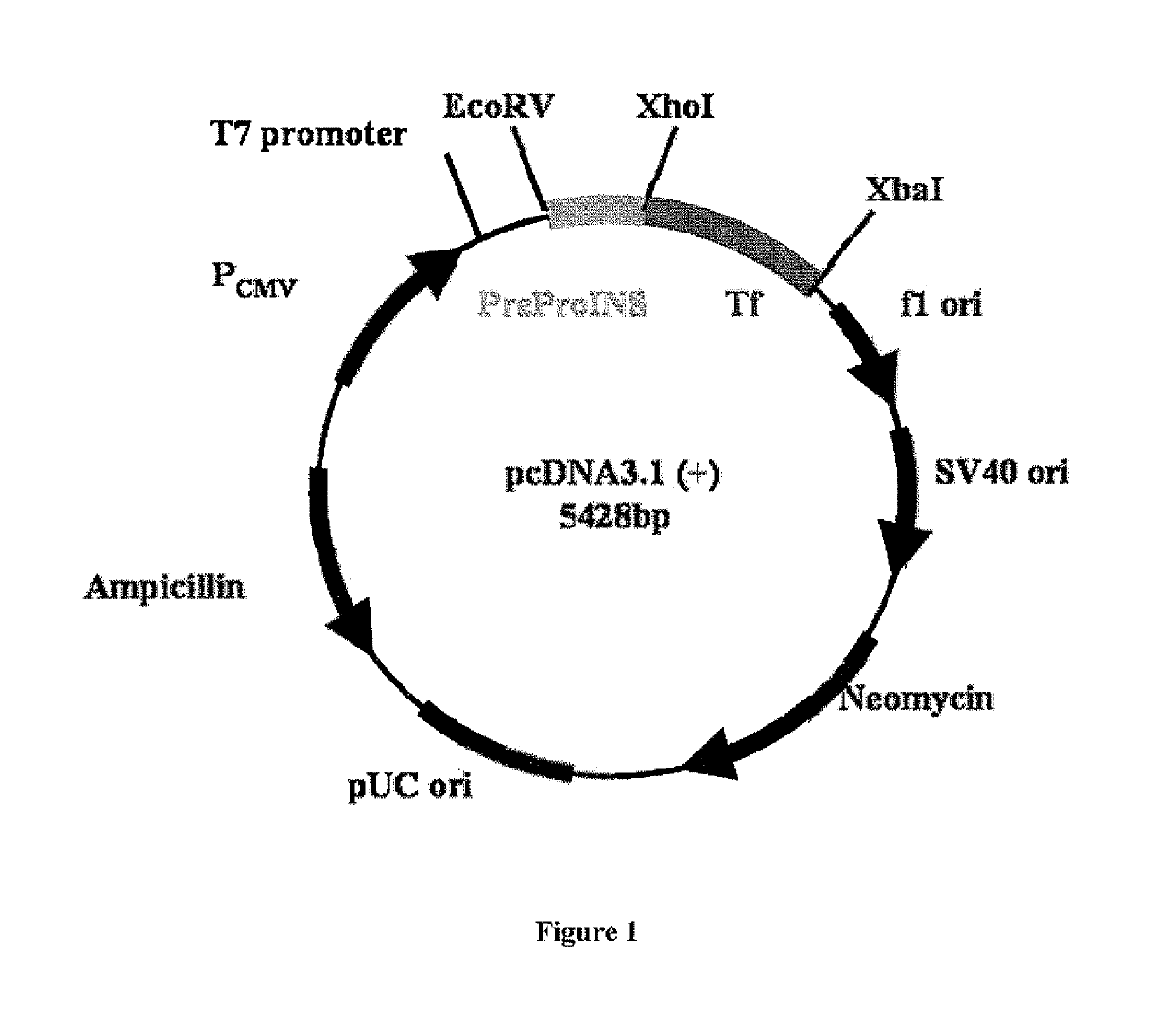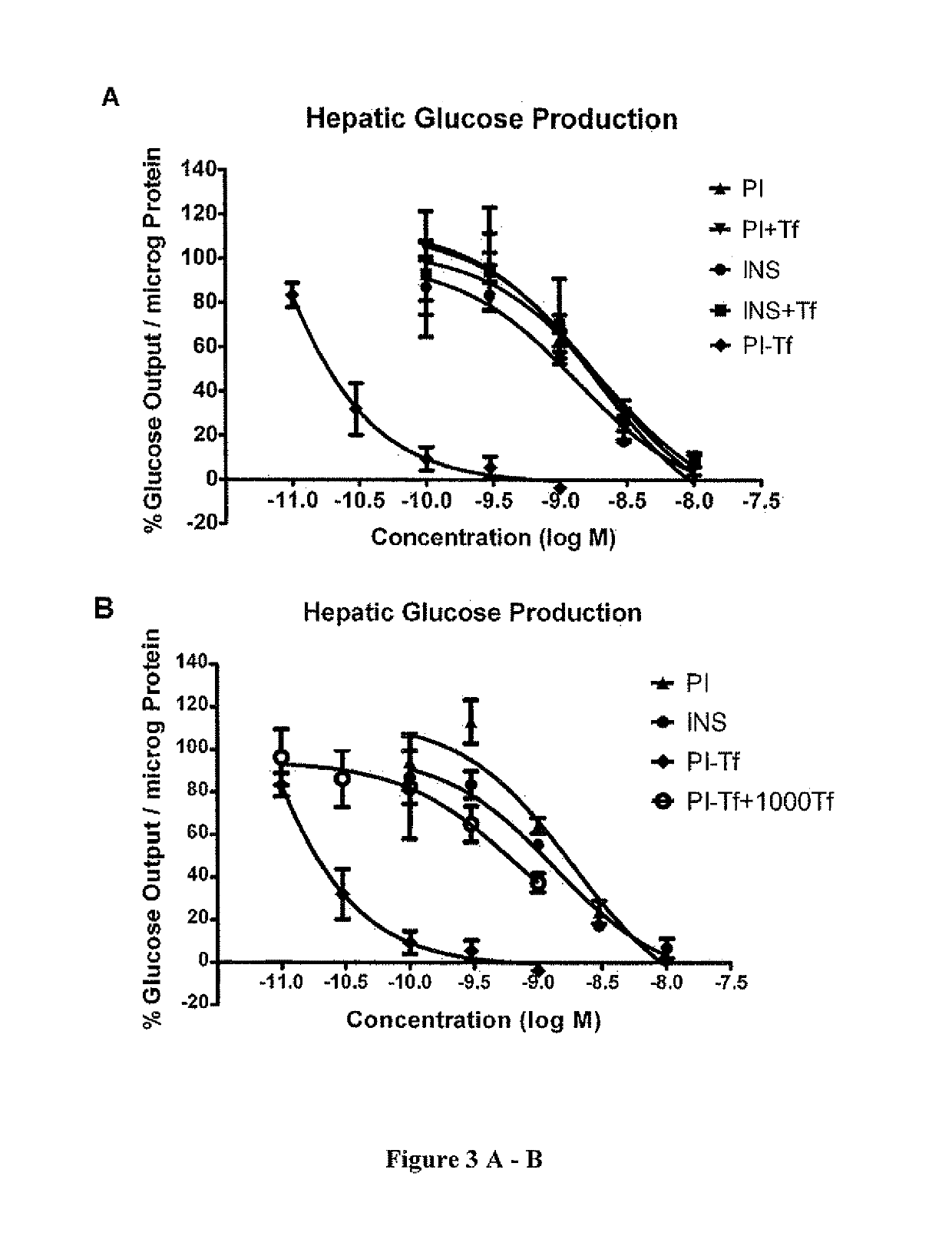Method for uses of proinsulin transferrin fusion proteins as prodrugs
a technology of proinsulin transferrin and fusion protein, which is applied in the direction of transferrins, fusions for specific cell targeting, peptide/protein ingredients, etc., can solve the problems of underinsulinized liver, increased peripheral glucose disposal effect, and inconvenient use, so as to increase the stability and sustained activity of insulin
- Summary
- Abstract
- Description
- Claims
- Application Information
AI Technical Summary
Benefits of technology
Problems solved by technology
Method used
Image
Examples
example 1
PI-Tf Recombinant Fusion Protein Expression and Characterization
[0036]Preproinsulin sequence (NM_000207) (SEQ ID NO: 1) fused in frame with Tf sequence (NM_001063) (SEQ ID NO: 2) was engineered into pcDNA3.1 (+) expression vector (Invitrogen, CA) by molecular cloning methods (FIG. 1). Plasmids containing preproinsulin-Tf fusion gene were transiently transfected to HEK 293 cells through polyethylenimine-mediated DNA transfection. Conditioned serum-free media were collected and concentrated by labscale tangential flow filtration system (Millipore, MA), and then ultrafiltered (CENTRICON®, Millipore, MA). PI-Tf fusion protein was characterized and quantified by Western blot using both anti-Tf (Sigma, MO) and anti-(pro)insulin antibodies (Abeam, MA). Anti-Tf and anti-(pro)insulin Western blots demonstrated the presence of a major band with molecular weight ˜89 kD, which indicated that PI-Tf fusion protein was successfully expressed and secreted into media. A leucine-glutamate dipeptide s...
example 2
Enhanced Inhibition of Hepatic Glucose Production by PI-Tf Fusion Protein in H4IIE Hepatoma Cells
[0037]Rat hepatoma H4IIE cells were cultured in high-glucose DMEM containing 10% fetal bovine serum. Upon confluency, cells were treated with different drugs for 24 hrs at 37° C. Cells were washed twice with phosphate buffered saline. Glucose production media consisting of serum-, glucose- and phenol red-free DMEM supplemented with 2 mM sodium pyruvate and 40 mM sodium DL-lactate were added to cells for additional 3-hr incubation. The supernatant was harvested and applied to measure glucose concentrations using the AMPLEX® Red Glucose / Glucose Oxidase kit (Invitrogen, CA) [5]. Cells were lysed in 1 M NaOH, and protein amount was quantified by BCA (Thermo Scientific, IL).
[0038]Proinsulin and insulin exhibited comparable inhibitory activities in glucose production with IC50 values of 1441.3±1641.6 pM and 1093.9±105.6 pM, respectively (FIG. 3A). Proinsulin bound to insulin receptor, but it h...
example 3
Conversion of PI-Tf to Insulin-Tf Fusion Protein by Hepatoma Cells
[0039]Rat hepatoma H4IIE cells (ATCC, VA) were treated with PI-Tf fusion protein in DMEM medium and incubated at 37° C. Media were collected at different time points, and subjected to insulin- and proinsulin-specific radioimmunoassays (Millipore, Mass.). Proinsulin and insulin concentrations were obtained based on standard curves from radioimmunoassays. After treatment in H4IIE cells for up to 24 hr, an insulin-containing species was continuously generated from PI-Tf fusion protein-treated samples, but not proinsulin-treated samples (FIG. 4). The generated insulin-containing species was suggested to be insulin-Tf instead of released insulin, since the two moieties were linked through stable peptide bonds. The conversion efficiency of PI-Tf to insulin-Tf was estimated 8.8% when dosed with 10 nM PI-Tf and 21.6% when dosed with 1 nM PI-Tf. These results demonstrated that the prohormone fusion protein PI-Tf can be convert...
PUM
| Property | Measurement | Unit |
|---|---|---|
| stability | aaaaa | aaaaa |
| size | aaaaa | aaaaa |
| chemical | aaaaa | aaaaa |
Abstract
Description
Claims
Application Information
 Login to View More
Login to View More - R&D
- Intellectual Property
- Life Sciences
- Materials
- Tech Scout
- Unparalleled Data Quality
- Higher Quality Content
- 60% Fewer Hallucinations
Browse by: Latest US Patents, China's latest patents, Technical Efficacy Thesaurus, Application Domain, Technology Topic, Popular Technical Reports.
© 2025 PatSnap. All rights reserved.Legal|Privacy policy|Modern Slavery Act Transparency Statement|Sitemap|About US| Contact US: help@patsnap.com



